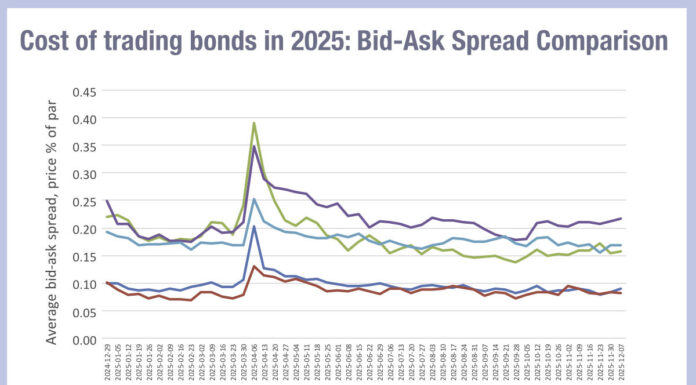An investment manager capable of making a price in less than a minute in Europe, or several minutes in the US, can be a liquidity provider. To do that requires a systematic trading capability.
There are some long-only asset management firms who might consider this capability to be unviable, because there is no economic incentive to invest in the data and technology needed to price the bonds quickly and to set targets for execution that would make systematic trading effective.
However, some quantitative investment houses shops believe there needs to be a change in mindset across the buy-side, starting with the attitude towards data collection. Over the past 15 years firms including AXA IM and AllianceBernstein have adopted the attitude of aggregating data in order to get a picture of the market pre-trade.
The same model attitude needs to be adopted for systematic credit trading, argue some on the buy side, as liquidity becomes scarcer and therefore flexibility in trading is more important.
To put that in perspective, all-to-all trading is growing apace, with Tradeweb’s AllTrade all-to-all volumes growing over 30% year on year (YoY) in the last quarter, while the number of all-to-all responders in the platform rose by over 20% and responses increased by 60% YoY.
There are some objections to this evolution. Some dealers note that if they are sending prices and axes to the buy-side, and these inform the pricing of buy-side price making, they will have to reconsider the way they interact with those clients.
Nevertheless, the advantages are clear. Firstly, relationships with dealers are improved by the provision of liquidity to such an extent that it has a material impact on the prices dealer provide to their counterparties.
A recent paper entitled ‘Relationship discounts in corporate bond trading’ and published by analysts at the Bank of England and the Bank of International Settlements found that buy-side liquidity providers to their sell-side counterparties get a considerable advantage, which exceeds those buy-side firms who have strong relationships based on the volume of trading of market signals they provide to clients.
“The results from our baseline panel regression imply that the top 1% of relationship clients face a sizable 51% (4.6 basis points) reduction in transaction costs relative to the median client,” they wrote. “This relationship discount maps to total annual savings of around £1.3m in transaction costs for the average top relationship client. These results are robust to various alternative specifications and show that there are important client-dealer relationships in the corporate bond market. Zooming in on the COVID-19 crisis stress episode, we find the decrease in transaction costs to be particularly important during stress times. The relationship discount more than doubled to above 10 basis points in this period. Having a relationship with a dealer is therefore particularly valuable during stress times, when top clients can trade bonds at much better prices compared to others.”
Systematic trading also allows for tighter analysis of execution performance, and therefore optimisation of performance both on the desk and via broker review.
There are necessary precursors – firms need the right quality of data to support the decision making process in a very low touch manner. They also need the analytics capabilities to process those decisions.
With so many systematic trading firms now engaged in the credit space, there seem little to argue against data quality – it clearly exists and therefore systematic trading can be done. For most asset managers the only question now is when, not if, they adopt it.
©Markets Media Europe 2025















